radiator cap GMC SIERRA 1994 Owners Manual
[x] Cancel search | Manufacturer: GMC, Model Year: 1994, Model line: SIERRA, Model: GMC SIERRA 1994Pages: 404, PDF Size: 20.91 MB
Page 221 of 404
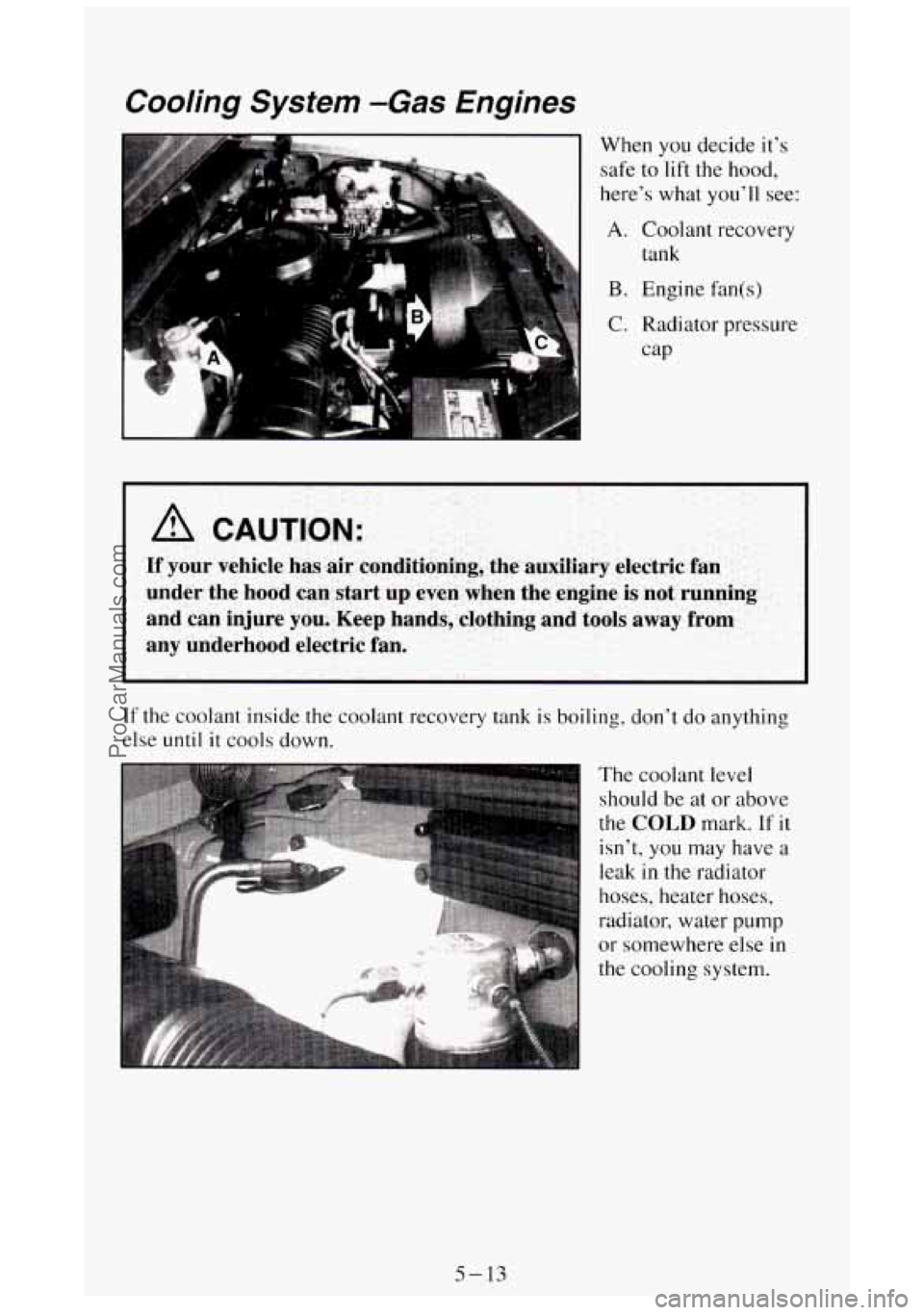
Cooling System -Gas Engines
When you decide it's
safe to lift the hood,
here's what you'll see:
A. Coolant recovery
tank
B. Engine fan(s)
C. Radiator pressure
cap
A CAUTION:
If your vehicle has air conditioning, the auxiliary electric fan
under the hood can start up even when
the engine is not running
and can injure you. Keep hands, clothing and tools away from
any underhood electric fan.
If the coolant inside the coolant recovery tank is boiling, don't do anything
else until it
cools down.
The coolant level
should be at or above
the
COLD mark. If it
isn't, you may have a
leak in the radiator
hoses, heater hoses,
radiator, water
pump
or somewhere else in
the cooling system.
5-13
ProCarManuals.com
Page 225 of 404

How to Add Coolant to the Radiator
1. You can remove the radiator pressure cap when the cooling system,
including the radiator pressure cap and upper radiator hose, is no longer
hot.
Turn the pressure cap slowly to the left until it first stops. (Don’t press
down while turning the pressure cap.)
If you hear a hiss, wait for that
to stop. A hiss means there is still some
pressure left.
I
r
5-17
ProCarManuals.com
Page 226 of 404

3. Fill the radiator
with the proper
mix, up to the
base
of the filler
neck.
4. Then fill the
coolant recovery
tank
to the
COLD mark.
5. Put the cap back
on the coolant
recovery tank,
but leave the
radiator pressure cap
off.
ProCarManuals.com
Page 227 of 404

I 6. Start the engine
and let it run
until
you can feel the
upper radiator
hose getting hot.
Watch out for
the
engine fan(s).
7. By this time the coolant level inside the radiator filler neck may be
lower.
If the level is lower, add more of the proper mix through the
filler neck until the level reaches the hase
of the filler neck.
8. Then replace the
pressure cap. At
any time during
this procedure
if
coolant begins to
flow out of the
filler neck,
reinstall the
pressure cap. Be
sure the arrows
on pressure cap
line up like this.
5-19
ProCarManuals.com
Page 231 of 404

1. You can remove the coolant surge tank pressure cap when the coolin\
g
system, including the coolant surge tank pressure cap and upper\
radiator hose, is no longer hot.
I
Turn the pressure cap slowly to the left until it first stops. (Don't press
down while turning the pressure cap.)
If you hear a hiss, wait for that to stop. A hiss means there is still some
pressure left.
2. Then keep
turning the cap,
but now push down as
you turn
it. Remove the
pressure cap.
5-23
ProCarManuals.com
Page 232 of 404
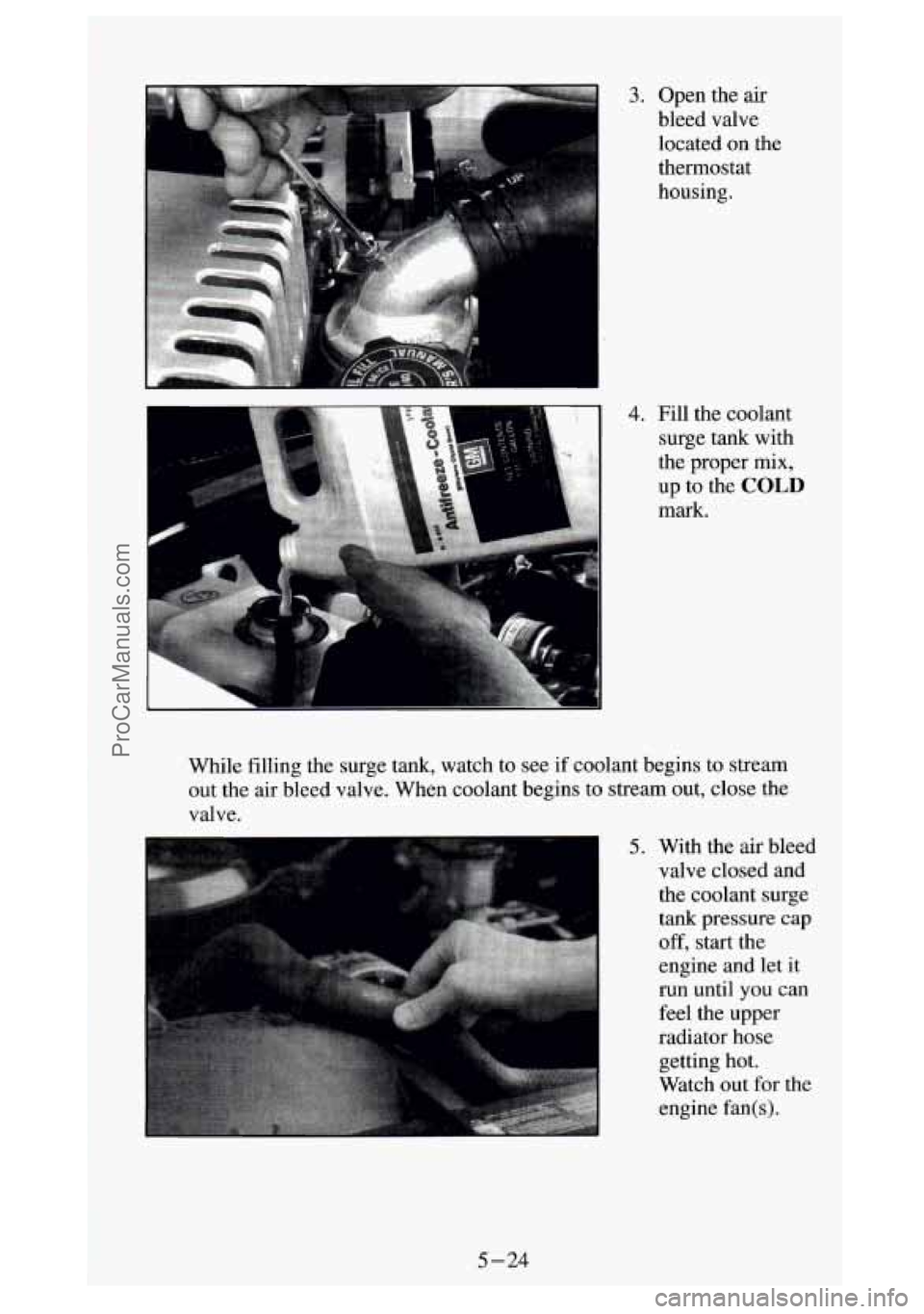
3. Open the air
bleed valve
located on the
thermostat
housing.
4. Fill the coolant
surge tank with
the proper mix,
up to the
COLD
mark.
While filling the surge tank, watch to see
if coolant begins to stream
out the air bleed valve. When coolant begins to stream out, close the
valve.
>. _:
5. With the air bleed
valve closed and
the coolant surge
tank pressure cap
off, start the
engine and let it
run until
you can
feel the upper
radiator hose getting hot.
Watch out for the
engine fan(s).
5-24
ProCarManuals.com
Page 290 of 404
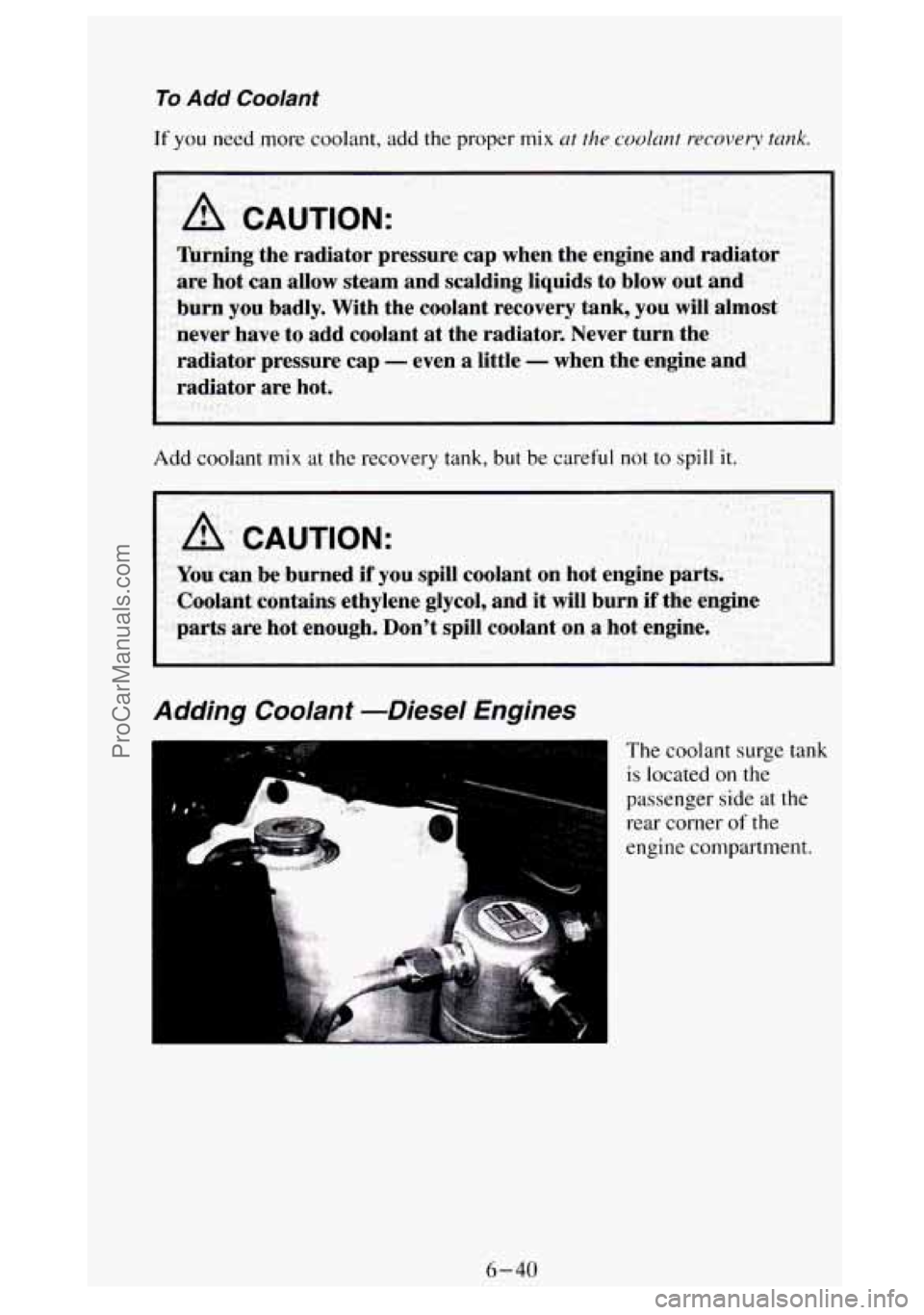
To Add Coolant
If you need more coolant, add the proper mix at the coolant recovery tunk.
A CAUTION:
Turning the radiator pressure cap when the engine and radiator
are hot can allow steam and scalding liquids to blow out and
burn you badly. With the coolant recovery tank, you will almost
never have to add coolant at the radiator. Never turn the
radiator pressure cap
- even a little - when the engine and
radiator are hot.
Add coolant mix at the recovery tank, but be careful not to spill it.
A CAUTION:
You can be burned if you spill coolant on hot engine parts.
Coolant contains ethylene glycol, and it will burn
if the engine
parts are hot enough. Don’t spill coolant on a hot engine.
Adding Coolant -Diesel Engines
The coolant surge tank
is located on the
passenger side at the
rear corner
of the
engine compartment.
6-40
ProCarManuals.com
Page 291 of 404

To Check Coolant
When your engine is cold, the coolant level should be at the COLD mark,
or a little higher. When your engine is warm, the level should be above the
COLD mark.
If this light comes on,
it means you’re low
on engine coolant.
To Add Coolant
If you need more coolant, add the proper mix at the surge tnnk, but only
when the engine is cool.
Open the air bleed valve on the thermostat housing to allow trapped air
out
of the system. Close the bleed valve when coolant begins to flow out.
I A CAUTION:
nrning the surge tank pressure cap when the engine and
radiator are hot can allow steam and scalding liquids to blow
out:
and burn you badly. Never turn the surge tank pressure cap -
even a little - when the engine and radiator are hot.
A CAUTION:
You can be burned if you spill coolant on hot engine parts.
Coolant contains ethylene glycol, and it will burn if the engine
parts are hot enough. Don’t spill coolant on
a hot engine.
6-41
ProCarManuals.com
Page 292 of 404
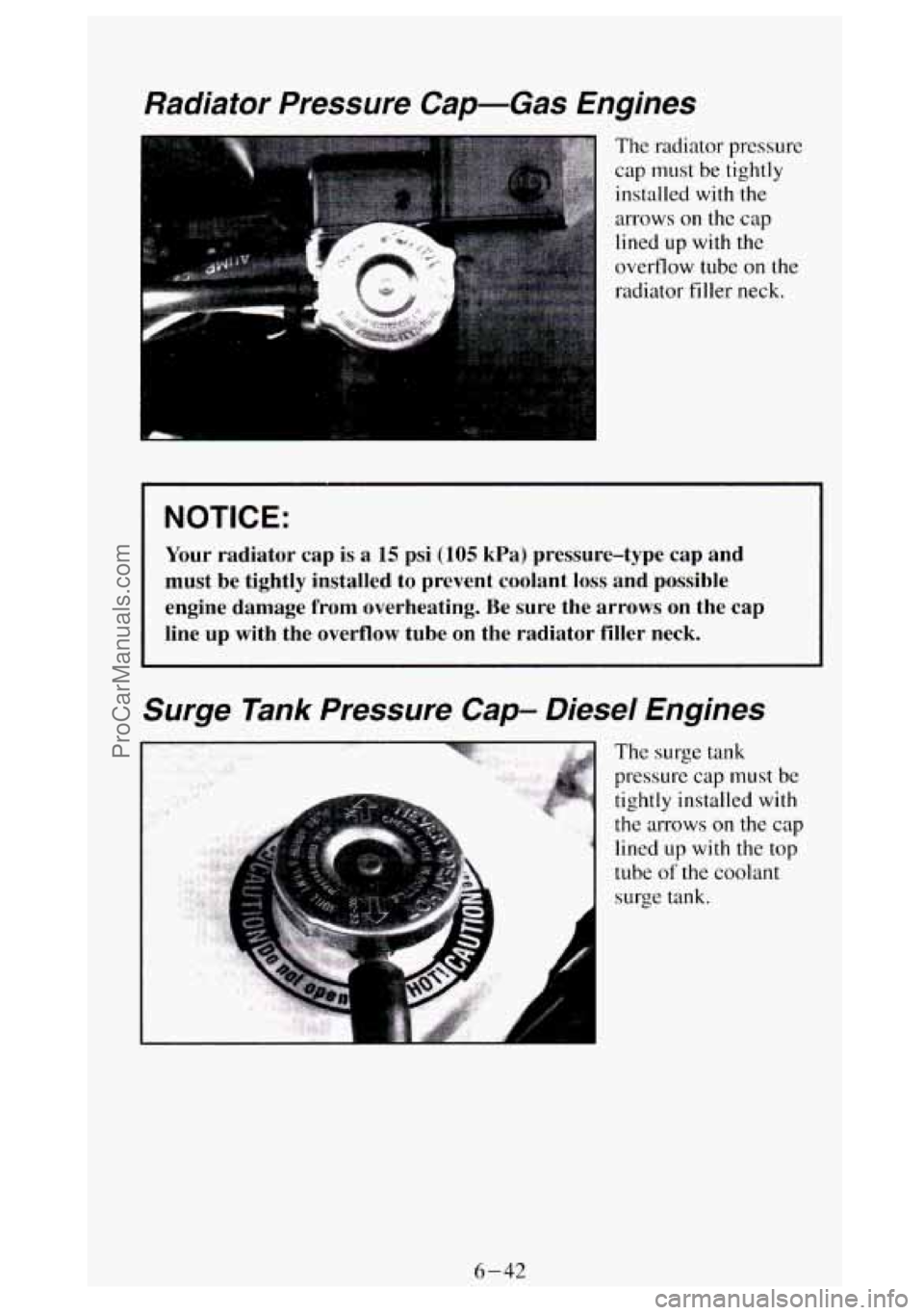
Radiator Pressure Cap-Gas Engines
The radiator pressure
cap must be tightly
installed with the
arrows
on the cap
lined
up with the
overflow tube
on the
radiator filler neck.
NOTICE:
Your radiator cap is a 15 psi (105 kPa) pressure-type cap and
must be tightly installed to prevent coolant
loss and possible
engine damage from overheating. Be sure the arrows
on the cap
line
up with the overflow tube on the radiator filler neck.
Surge Tank Pressure Cap- Diesel Engines
6-42
ProCarManuals.com
Page 293 of 404
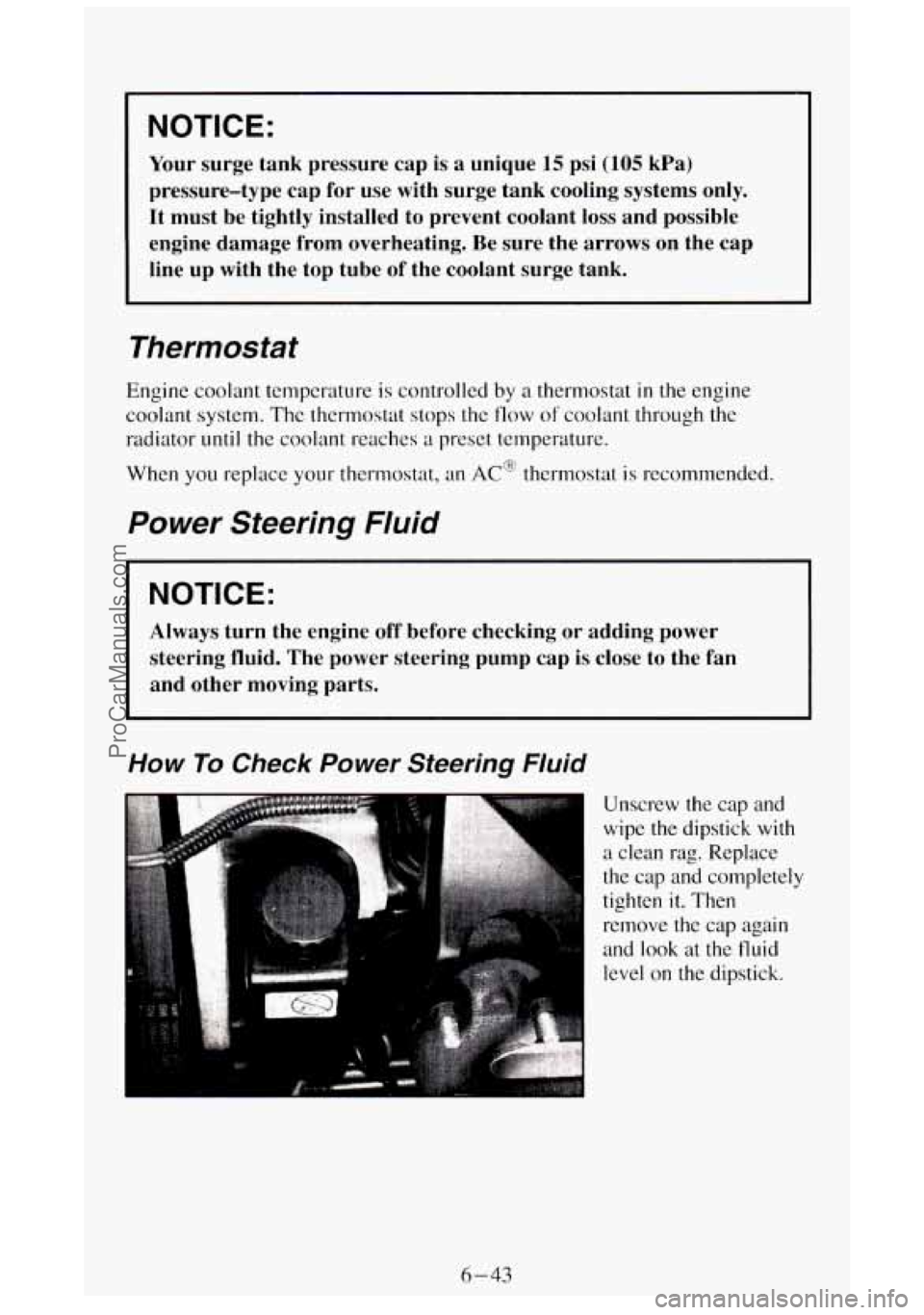
NOTICE:
Your surge tank pressure cap is a unique 15 psi (105 kPa)
pressure-type cap for use with surge tank cooling systems only.
It must be tightly installed to prevent coolant
loss and possible
engine damage from overheating. Be sure the arrows on the cap
line up with the top tube
of the coolant surge tank.
Thermostat
Engine coolant temperature is controlled by a thermostat in the engine
coolant system. The thermostat stops
the flow of coolant through the
radiator
until the coolant reaches a preset temperature.
When
you replace your thermostat, an AC" thermostat is recommended.
Power Steering Fluid
NOTICE:
Always turn the engine off before checking or adding power
steering fluid. The power steering pump cap is close to the fan
and other moving parts.
How To Check Power Steering Fluid
Unscrew the cap and
wipe the dipstick
with
a clean rag. Replace
the cap and completely
tighten it. Then
remove the cap again
and
look at the fluid
level on the dipstick.
6-43
ProCarManuals.com